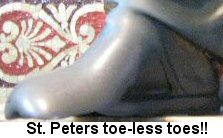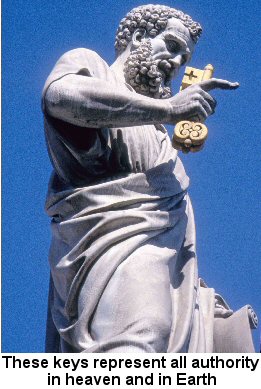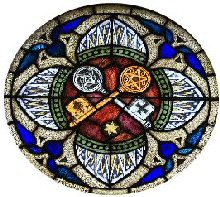Chapter
10
WAS PETER THE FIRST POPE?
STANDING AT THE HEAD of the
Roman Catholic church is the Pope of Rome. This man--according to
Catholic doctrine--is the earthly head of the church and successor
of the apostle Peter.
According to
this belief, Christ appointed Peter as the first pope, who in turn
went to Rome and served in this capacity for twenty--five
years. From him, it is claimed, a succession of popes has
continued to this day--a very important part of Roman Catholic
doctrine. But did Christ ordain one man to be above all
others in his church? Did he institute the papal
office? Did he appoint Peter as the Supreme Pontiff?
According to the Scriptures, CHRIST "is the head of the
church" (Eph. 5:23)--not the Pope!

The photo to the right shows the toe--less toes
of Peter, that is located in St. Peter's at Rome. Long lines
of people wait daily to pass before it and kiss its foot.
Bronze statue of St Peter - the feet have been made toe-less from
thousands of people touching them over the years. More on the
toes in the next chapter.
James and John
once came to Jesus asking if one of them might sit on his right
hand and the other on his left in the kingdom. (In Eastern
kingdoms, the two principal minsters of state, ranking next in
authority to the king, hold these positions.) If the Roman
Catholic claim is true, it seems that Jesus would have explained
he had given the place on his right to Peter, and did not intend
to create any position on the left! But to the contrary, here was
the answer of Jesus: "Ye know that the princes of the Gentiles
exercise dominion over them, and they that are great exercise
dominion upon them, but it shall not be so among you" (Mark.
10:35-43). Certainly this argues against the concept that one of
them was to be a Pope ruling over all others in the church as
Bishop of bishops!
Jesus further
taught the concept of equality by warning the disciples against
the use of flattering religious titles such as "Father" (the word
"Pope" means father), "Rabbi," or "Master." "For one is your
Master, even Christ," he said, "and all ye are brethren" (Matt.
23:4-10).
But Roman
Catholics are taught that Peter was given such a superior position
that the entire church was built upon him! The verse that is used
to support this claim is Matthew 16: 18: "And I say unto thee,
that thou art Peter, and upon this rock I will build my church;
and the gates of hell shall not prevail against it."
If we take
this verse in its setting, however, we can see that the church was
not built on Peter, but on CHRIST.
In the verses just before, Jesus asked the disciples who men were
saying that he was. Some said he was John the Baptist, some
Elijah: others thought he was Jeremiah or one of the prophets.
Then Jesus asked: "But whom say ye that I am?" To this Peter
replied: "Thou art the Christ, the Son of the living God."
Then it was that Jesus said, "Thou art Peter (petros--a stone, a
rock), and upon this rock (petra--a mass of rock, the great
foundation rock of truth that Peter had just expressed) I will
build my church." The true foundation upon which the church
was built was Christ himself, not Peter. It is, in fact,
Christ's church, not St. Peter's!
Peter himself
declared that Christ was the foundation rock (1 Peter 2:4-8). He
spoke of Christ as "the stone which was set at naught of you
builders...neither is there salvation in any other" (Acts 4:1
1,12). The church was built on Christ. He is the true
foundation and there is no other foundation: "For other foundation
can no man lay than that is laid, which is JESUS CHRIST" (1 Cor, 3:11).
When Jesus spoke of building his church upon a
rock, the disciples did not take this to mean he was exalting Peter
to be their Pope, for two chapters later they asked Jesus who was
the GREATEST (Matt. 18:
1). If Jesus taught the church would be built on Peter, the
disciples would have automatically known who was the greatest among
then!
Actually, it
was not until the time of Calixtus, who was bishop of Rome from
218 to 223 that Matthew 16: 18 was used in an attempt to prove the
church was built on Peter and that the bishop of Rome was his
successor.
If we take a close look at Peter in the Scriptures, it becomes
apparent that he was not a Pope!
|
|
1. Peter was married. The
fact that Peter was a married man does not harmonize with
the Catholic position that a pope is to be unmarried. The
Scriptures tell us that Peter's wife's mother was healed
of a fever (Matt. 8: 14). Of course there couldn't be a
"Peter's wife's mother" if Peter didn't have a wife!
Even years later, Paul made a statement which shows the
apostles had wives--including Cephas ( I Cor. 9:5). Cephas
was Peter's Aramaic name (John l:42)
.
2. Peter would not allow
men to bow down to him. When Peter came into his
house, "Cornelius met him, and fell down at his feet, and
worshiped him. But Peter took him up, saying, Stand up; I
myself am a man" (Acts l10:25,26). This was quite
different from what a pope might have said, for men do bow
before the pope.
3. Peter did not place
tradition on a level with the word of God. To the
contrary, Peter had little faith in "traditions from your
fathers" (l Peter I :18). His sermon on the day of
Pentecost was filled with the Word, not traditions of
men. When the people asked what they should do to
get right with God, Peter did not tell them to have a
little water poured or sprinkled on them. Instead, he
said: "Repent and be baptized everyone of you in the name
of Jesus Christ for the remission of sins, and ye shall
receive the gift of the Holy Ghost" (Acts 2:38).
4. Peter was not a pope,
for he wore no crown Peter himself explained that when the
chief shepherd shall appear, then shall we "receive a
crown of glory that fadeth not away" (1 Peter 5:4). Since
Christ has not yet appeared again, the crown that the Pope
weans is not one bestowed upon him by Christ. In short,
Peter never acted like a pope, never dressed like a pope,
never spoke like a pope, never wrote like a pope, and
people did not approach him as a pope!
|
|
In all
probability, in the very early days of the church, Peter did have
the most prominent ministry among the apostles. It was Peter
who preached the first sermon after the outpouring of the Holy
Spirit at Pentecost and 3,000 were added to the Lord. Later, it
was Peter who fir,st took the gospel to the Gentiles.
Whenever we find a list of the twelve apostles in the Bible,
Peter's name is always mentioned first (Matt. 10:2; Mk. 3:16;
Luke. 6:14; Acts 1:13). But none of his--not by any stretch
of the imagination-would indicate that Peter was the Pope or
universal Bishop of bishops!

While Peter
apparently took the most outstanding role of the apostles at the
very beginning, later on, Paul seems to have had the most
outstanding ministry. As a writer of the New Testament, Paul
wrote l00 chapters with 2,325 verses, while Peter only wrote 8
chapters with 166 verses.
Paul spoke of
Peter, James, and John as pillars in the church (Gal.2:9).
Nevertheless, he could say, "In nothing am I behind the very
chiefest apostles" (2 Cor. 12:1 1). But if Peter was the
Supreme Pontiff, the Pope, then certainly Paul would have been
somewhat behind him! On one occasion, Paul even gave a rebuke to
Peter "because he was to be blamed" (Gal. 2:11). This is
strange wording if Peter was regarded as an "infallible" pope!
Paul was called
"the apostle of the Gentiles" (Rom. 11:13), whereas Peter's
ministry was primarily to the Jews (Gal. 2:7-9). This fact--in
itself--would seem sufficient to show Peter was not bishop of
Rome, for Rome was a Gentile city (Acts 18:2). All of this
is indeed highly significant when we consider that the entire
framework of Roman Catholicism is based on the claim that Peter
was Rome's first bishop!
There is no
proof, Biblically speaking, that Peter ever went near Rome! We
read about his trips to Antioch, Samaria, Joppa, Caesarea, and
other places, but not Rome! This is a strange omission,
especially since Rome was considered the most important city in
the world!

The Catholic
Encyclopedia (article: 'Peter") points out that a tradition
appeared as early as the third century for the belief that Peter
was bishop of Rome for twenty--five years--these years being (as
Jerome believed) from 42 A.D. until 67 A.D. But this viewpoint is
not without distinct problems. About the year 44, Peter was
in the council at Jerusalem (Acts 15). About 53, Paul joined him
in Antioch (Gal. 2:l1). About 58, Paul wrote his letter to the
Christians at Rome in which he sent greetings to twenty-seven
persons, but never mentioned Peter! Imagine a missionary writing
to a church, greeting twenty--seven of the members by name, but
never mentioning the pastor!
The keys in the
above picture and to the right are supposed to represent the "keys
of the kingdom" that was given to Peter in Matthew 16:19.
According to Roman Catholicism, these keys represent all authority
in heaven and in Earth, and she (Catholicism), as the "rightful
possessor" through the passing of those keys, has all authority.
Pope Gregory VII (the "only pope to canonize himself") drew up a
Dictatus (list) of twenty- seven theses outlining his powers as
"Peter’s vicar, Prince of the Apostles and Chief Shepherd".
It is Catholic doctrine, that, by changing Simon’s name to
Peter, was making him the first pope and head of the Roman
Catholic church as well as establishing apostolic succession.
Catholic popes would be given these keys of Peter to reign as
"Pontifex Maximus" in Rome, a
title held by the
Caesars of
Rome as well.
“Signs and symbols rule the Sun Worship world, not
words nor laws.”
www.granddesignexposed.com
 While Peter
apparently took the most outstanding role of the apostles at the
very beginning, later on, Paul seems to have had the most
outstanding ministry. As a writer of the New Testament, Paul
wrote l00 chapters with 2,325 verses, while Peter only wrote 8
chapters with 166 verses.
While Peter
apparently took the most outstanding role of the apostles at the
very beginning, later on, Paul seems to have had the most
outstanding ministry. As a writer of the New Testament, Paul
wrote l00 chapters with 2,325 verses, while Peter only wrote 8
chapters with 166 verses.
